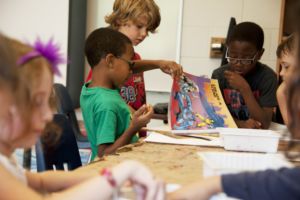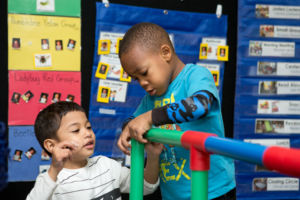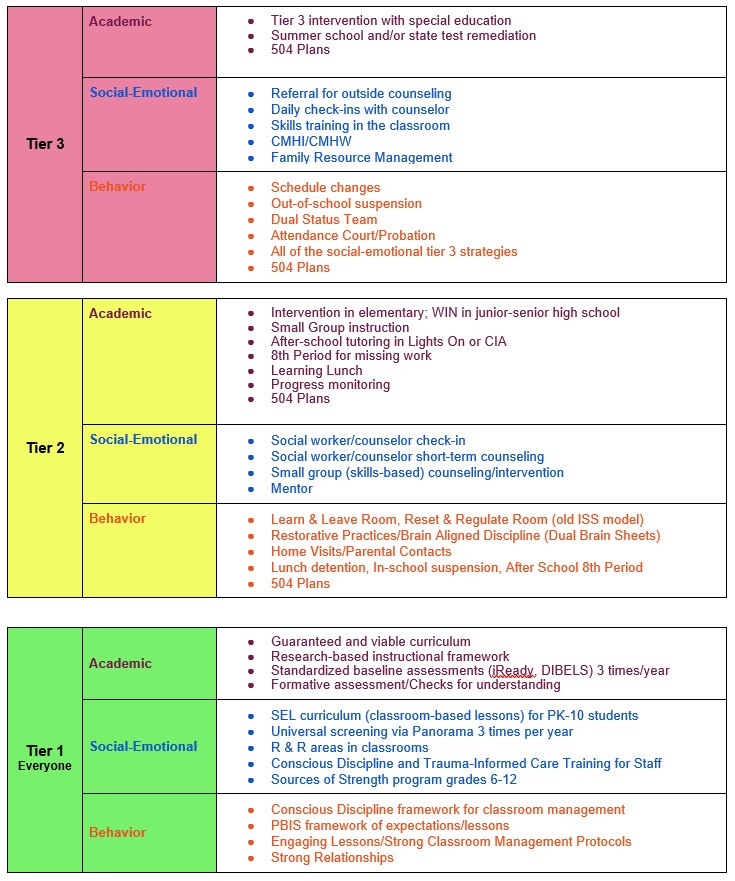As you hopefully recall from MTSS Blog #1 shared in October, some important components of the original RtI process were reviewed. We also discussed how that academic portion has been entered into the Multi-Tiered System of Supports (MTSS) model. In this second blog, we will dig a little deeper to venture into the other two areas, behavioral and emotional, in order to capture the whole-child learner.
“there is a strong belief educators can, and must, attend to the development of the whole child while also striving to achieve excellence in academics.”
According to information from wholechildmodel.org, responding to the needs of the whole child includes understanding that children’s academic success is vitally linked to the overall well-being of each child. Within this model, there is a strong belief educators can, and must, attend to the development of the whole child while also striving to achieve excellence in academics. This means that within this model, educators help children build both intra and interpersonal skills they need to keep their emotions regulated, learn strategies to manage stress, as well as ways to productively handle conflicts. These beliefs fully support all students’ socio-emotional growth, while progressing academically.

One vital piece to these other areas of the MTSS is a comprehensive and scaffolded social-emotional learning (SEL) curriculum. (Tier 1 in Socio-Emotional on the MTSS table.) There are many programs available to purchase, along with free resources on internet websites. We are fortunate to be in a state affiliated with Dr. Lori Desautels and her work at Butler University in the area of Neuroscience in Education. Her website, revelationsineducation.com, provides a plethora of resources for SEL curriculum ideas. She even has a resource: 180 days of Educational Neuroscience (180 days are in a school year!). There are SEL learning competencies, along with lesson plans to teach these competencies on the website. Our corporation has taken concepts from the Conscious Discipline Framework by Dr. Becky Bailey, and Dr. Desautels’ research in Educational Neuroscience and developed our own personalized SEL curriculum. As with anything, it is tweaked and revised as we learn more, and we try to meet the needs of various groups of students who come through our doors. We have found that these curricular pieces are just as vital as a core subject area, and need to be led by classroom teachers and teachable moments throughout the week are seized by them in order to make “real-life” connections to these lessons.
“We have tried to incorporate similar SEL Art, Music, and even PE lessons into their day to try to connect as many areas of learning as possible.”

We have tried to incorporate similar SEL Art, Music, and even PE lessons into their day to try to connect as many areas of learning as possible. The Art and Music lessons mainly come from Conscious Discipline’s “Feeling Buddies” curriculum (www.consciousdiscipline.com). For example, in art class, our students learn about feelings then have an art activity that goes with that feeling. Our music classes begin with a SEL lesson about feelings, accompanied with an upbeat feeling song from the Conscious Discipline CD. We learn about how music affects us when we are feeling a certain way, and every class ends with the famous “We Wish You Well” song. Dr. Desautels also has multiple activities involving rhythm and drumming that could be incorporated into any music lesson. Again, check out her website! Another resource for integrating PE and SEL can be found in blog.shapeamerica.org: How to Integrate SEL in PE.
The behavior section of the MTSS model is probably one of the most difficult areas to develop and grow in the different tiers. In my experience, the first step in this area is to have clearly defined expectations for both students and staff for behavior. What does “good” look like in every location in the school? What do adult responsibilities look like no matter the role of the adult? What are consequences/learning activities when those expectations aren’t met? How do we as adults intervene when we see inappropriate behavior? We have found that our PBIS (Positive Behavior Intervention Supports) Manual has helped with this tremendously. Now, having the manual doesn’t make the magic happen…. These expectations are reviewed frequently by the staff and students, especially after any long break (after fall, winter, and spring breaks), and any other times we seem to run into consistent struggles in certain areas (lunchroom, recess, restrooms, etc.). These expectations are reviewed each year, and revised as needed. All new staff members receive training on the manual, and just like the students, we review the adult responsibilities quarterly (yes, adults need reminders, too!).
Hopefully after viewing all tiers (Tier 1,2,3) in all areas (Academic, Social-Emotional, Behavior) in the table below, you may be able to brainstorm with your school leadership team and develop your own ‘menu’ of ideas to meet the needs of every student with a whole-child perspective.
May the systems of supports be with all of you!
One School Corporation Multi-Tiered System of Supports


